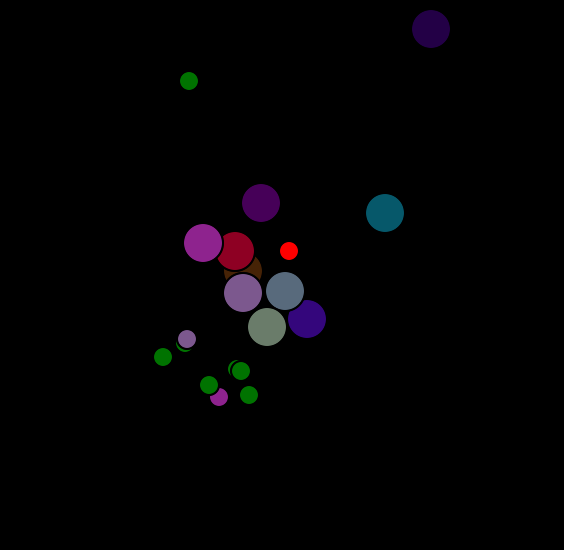The cloud computing based mobile applications, such as augmented reality (AR), face recognition, and object recognition have become popular in recent years. However, cloud computing may cause high latency and increase the backhaul bandwidth consumption because of the remote execution. To address these problems, edge computing can improve response times and relieve the backhaul pressure by moving the storage and computing resources closer to mobile users.
Considering the computational resources, migration bandwidth, and offloading target in an edge computing environment, the project aims to use Deep Deterministic Policy Gradient (DDPG), a kind of Reinforcement Learning (RL) approach, to allocate resources for mobile users in an edge computing environment.
 picture originated from: IEEE Inovation at Work
picture originated from: IEEE Inovation at Work
- Python 3.7.5
- Tensorflow 2.2.0
- Tkinter 8.6
$ python3 src/run_this.pyTEXT_RENDER = True / FalseSCREEN_RENDER = True / False-
Mobile User
- Users move according to the mobility data provided by CRAWDAD. This data was collected from the users of mobile devices at the subway station in Seoul, Korea.
- Users' devices offload tasks to one edge server to obtain computation service.
- After a request task has been processed, users need to receive the processed task from the edge server and offload a new task to an edge server again.
-
Edge Server
- Responsible for offering computational resources (6.3 * 1e7 byte/sec) and processing tasks for mobile users.
- Each edge server can only provide service to limited numbers of users and allocate computational resources to them.
- The task may be migrated from one edge server to another within limited bandwidth (1e9 byte/sec).
-
Request Task: VOC SSD300 Objection Detection
- state 1 : start to offload a task to the edge server
- state 2 : request task is on the way to the edge server (2.7 * 1e4 byte)
- state 3 : request task is proccessed (1.08 * 1e6 byte)
- state 4 : request task is on the way back to the mobile user (96 byte)
- state 5 : disconnect (default)
- state 6 : request task is migrated to another edge server
-
Graphic Interface
- Edge servers (static)
- Big dots with consistent color
- Mobile users (dynamic)
- Small dots with changing color
- Color
- Red : request task is in state 5
- Green : request task is in state 6
- others : request task is handled by the edge server with the same color and is in state 1 ~ state 4
- Edge servers (static)
-
Description
While determining the offloading server of each user is a discrete variable problem, allocating computing resources and migration bandwidth are continuous variable problems. Thus, Deep Deterministic Policy Gradient (DDPG), a model-free off-policy actor-critic algorithm, can solve both discrete and continuous problems. Also, DDPG updates model weights every step, which means the model can adapt to a dynamic environment instantly.
-
State
def generate_state(two_table, U, E, x_min, y_min): one_table = two_to_one(two_table) S = np.zeros((len(E) + one_table.size + len(U) + len(U)*2)) count = 0 for edge in E: S[count] = edge.capability/(r_bound*10) count += 1 for i in range(len(one_table)): S[count] = one_table[i]/(b_bound*10) count += 1 for user in U: S[count] = user.req.edge_id/100 count += 1 for user in U: S[count] = (user.loc[0][0] + abs(x_min))/1e5 S[count+1] = (user.loc[0][1] + abs(y_min))/1e5 count += 2 return S
- Available computing resources of each edge server
- Available migration bandwidth of each connection between edge servers
- Offloading target of each mobile user
- Location of each mobile user
-
Action
def generate_action(R, B, O): a = np.zeros(USER_NUM + USER_NUM + EDGE_NUM * USER_NUM) a[:USER_NUM] = R / r_bound # bandwidth a[USER_NUM:USER_NUM + USER_NUM] = B / b_bound # offload base = USER_NUM + USER_NUM for user_id in range(USER_NUM): a[base + int(O[user_id])] = 1 base += EDGE_NUM return a
- Computing resources of each mobile user's task need to uses(continuous)
- Migration bandwidth of each mobile user's task needs to occupy (continuous)
- Offloading target of each mobile user (discrete)
-
Reward
- Total processed tasks in each step
-
Model Architecture
-
Simulation Environment
- 10 edge servers with computational resources 6.3 * 1e7 byte/sec
- Each edge server can provide at most 4 task processing services.
- 3000 steps/episode, 90000 sec/episode
-
Result
Number of Clients Average Total proccessed tasks in the last 10 episodes Training History 10 11910 
20 23449 
30 33257 
40 40584 
-
Demo Environment
- 35 mobile users and 10 edge servers in the environment
- Each edge server can provide at most 4 task processing services.
-
Demo Video


